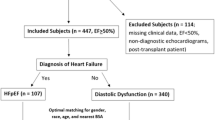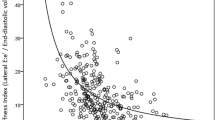Abstract
Increased vascular stiffness is known to be an independent predictor of mortality in patients with heart failure with reduced ejection fraction (HFrEF). The effects of sacubitril–valsartan on vascular structure and function have not been systematically studied in this patient population. We hypothesized that aortic distensibility (AD) and fractional area change (AFAC), as assessed by 2D transthoracic echocardiography (TTE), would improve over time in HFrEF patients on sacubitril–valsartan therapy, due to the vasodilatory properties of the medication. We prospectively studied 30 patients with HFrEF (25 < EF < 40%) on optimal guideline-directed medical therapy who were subsequently started on sacubitril–valsartan. Patients underwent serial 2D TTE imaging at baseline, 3 and 6 months following therapy initiation. Ascending aortic diameters were measured 3 cm above the aortic valve in the parasternal long-axis view and used to calculate AD and AFAC, two markers of vascular compliance. For reference, we also measured AD and AFAC in 30 healthy, age and gender-matched controls at a single time point. Normal controls had significantly higher values of AD and AFAC than HFrEF patients at baseline (AD: 4.0 ± 1.1 vs. 2.2 ± 0.9 cm2dyne−110−3, p < 0.0001 and AFAC: 18.8 ± 3.7% vs. 10.3 ± 4.3%, p < 0.0001). In HFrEF patients on sacubitril–valsartan, both indices of aortic compliance progressively improved towards normal from baseline to 6 months: AD from 2.2 ± 0.9 to 3.6 ± 1.5 cm2dyne−110−3 (p < 0.0001) and AFAC from 10.3 ± 4.3 to 13.7 ± 4.1% (p < 0.0001). In conclusion, AD and AFAC are decreased in patients with HFrEF and gradually improve with sacubitril–valsartan treatment. The echocardiographic markers used in this study may become a useful tool to assess the effectiveness of sacubitril–valsartan therapy in HFrEF patients.



Similar content being viewed by others
References
Cavalcante JL, Lima JA, Redheuil A, Al-Mallah MH (2011) Aortic stiffness: current understanding and future directions. J Am Coll Cardiol 57(14):1511–1522
Cruickshank K, Riste L, Anderson SG, Wright JS, Dunn G, Gosling RG (2002) Aortic pulse-wave velocity and its relationship to mortality in diabetes and glucose intolerance: an integrated index of vascular function? Circulation 106(16):2085–2090
Laurent S, Boutouyrie P, Asmar R et al (2001) Aortic stiffness is an independent predictor of all-cause and cardiovascular mortality in hypertensive patients. Hypertension 37(5):1236–1241
Demir S, Akpinar O, Akkus O et al (2013) The prognostic value of arterial stiffness in systolic heart failure. Cardiol J. 20(6):665–671
Yancy CW, Jessup M, Bozkurt B et al (2013) 2013 ACCF/AHA guideline for the management of heart failure: executive summary: a report of the American College of Cardiology Foundation/American Heart Association Task Force on practice guidelines. Circulation 128(16):1810–1852
McMurray JJ, Packer M, Desai AS et al (2014) Angiotensin-neprilysin inhibition versus enalapril in heart failure. N Engl J Med 371(11):993–1004
Kim KH, Park JC, Yoon HJ et al (2009) Usefulness of aortic strain analysis by velocity vector imaging as a new echocardiographic measure of arterial stiffness. J Am Soc Echocardiogr 22(12):1382–1388
Stefanadis C, Stratos C, Boudoulas H, Kourouklis C, Toutouzas P (1990) Distensibility of the ascending aorta: comparison of invasive and non-invasive techniques in healthy men and in men with coronary artery disease. Eur Heart J 11(11):990–996
Lang RM, Badano LP, Mor-Avi V et al (2015) Recommendations for cardiac chamber quantification by echocardiography in adults: an update from the American Society of Echocardiography and the European Association of Cardiovascular Imaging. J Am Soc Echocardiogr 28(1):1–39
Stefanadis C, Wooley CF, Bush CA, Kolibash AJ, Boudoulas H (1987) Aortic distensibility abnormalities in coronary artery disease. Am J Cardiol 59(15):1300–1304
Sethi S, Rivera O, Oliveros R, Chilton R (2014) Aortic stiffness: pathophysiology, clinical implications, and approach to treatment. Integr Blood Press Control. 7:29–34
Chirinos JA, Kips JG, Jacobs DR Jr et al (2012) Arterial wave reflections and incident cardiovascular events and heart failure: MESA (Multiethnic Study of Atherosclerosis). J Am Coll Cardiol 60(21):2170–2177
Ooi H, Chung W, Biolo A (2008) Arterial stiffness and vascular load in heart failure. Congest Heart Fail. 14(1):31–36
Yancy CW, Jessup M, Bozkurt B et al (2017) 2017 ACC/AHA/HFSA focused update of the 2013 ACCF/AHA guideline for the management of heart failure: a Report of the American College of Cardiology/American Heart Association Task Force on Clinical Practice Guidelines and the Heart Failure Society of America. Circulation 136(6):e137–e161
Sackner-Bernstein JD, Mancini DM (1995) Rationale for treatment of patients with chronic heart failure with adrenergic blockade. JAMA 274(18):1462–1467
Ma TK, Kam KK, Yan BP, Lam YY (2010) Renin-angiotensin-aldosterone system blockade for cardiovascular diseases: current status. Br J Pharmacol 160(6):1273–1292
Williams B, Cockcroft JR, Kario K et al (2017) Effects of sacubitril/valsartan versus olmesartan on central hemodynamics in the elderly with systolic hypertension: the PARAMETER study. Hypertension 69(3):411–420
Schmieder RE, Wagner F, Mayr M et al (2017) The effect of sacubitril/valsartan compared to olmesartan on cardiovascular remodelling in subjects with essential hypertension: the results of a randomized, double-blind, active-controlled study. Eur Heart J 38(44):3308–3317
Tsao CW, Lyass A, Larson MG et al (2015) Relation of central arterial stiffness to incident heart failure in the community. J Am Heart Assoc. 4(11):e002189
Lam CS, Gona P, Larson MG et al (2013) Aortic root remodeling and risk of heart failure in the Framingham Heart study. JACC Heart Fail. 1(1):79–83
Vlachopoulos C, Aznaouridis K, Stefanadis C (2010) Prediction of cardiovascular events and all-cause mortality with arterial stiffness: a systematic review and meta-analysis. J Am Coll Cardiol 55(13):1318–1327
Funding
The study was supported by a research Grant from Novartis.
Author information
Authors and Affiliations
Corresponding author
Ethics declarations
Conflict of interest
The authors declare that they have no competing interest.
Additional information
Publisher's Note
Springer Nature remains neutral with regard to jurisdictional claims in published maps and institutional affiliations.
Rights and permissions
About this article
Cite this article
Karagodin, I., Kalantari, S., Yu, D.B. et al. Echocardiographic evaluation of the effects of sacubitril–valsartan on vascular properties in heart failure patients. Int J Cardiovasc Imaging 36, 271–278 (2020). https://doi.org/10.1007/s10554-019-01708-4
Received:
Accepted:
Published:
Issue Date:
DOI: https://doi.org/10.1007/s10554-019-01708-4




